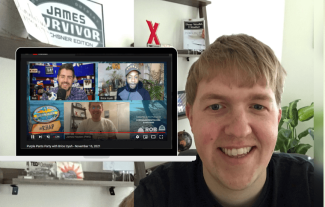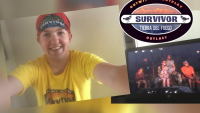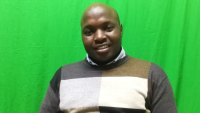My call to a YouTube live event

When his favourite podcast was holding a YouTube Live event, James Hayden, our regular contributor from the U.S., just had to call in. But would negative thoughts get the better of him? How would the presenters and audience react to his stammer?
By this point in our relationship, dear reader, I think it's safe to say you might know I'm a superfan of the TV show Survivor. For those of you who don't know, Survivor is a reality show that's popular here in the US but I understand was cancelled in the UK and I wrote an article for Your Voice about it. Look at my Twitter or Facebook bio and you'll see '4 x Survivor applicant. 0 x contestant'.
Every week I listen to several hours-worth of podcasts about it, the main one being 'Rob Has A Podcast (RHAP)'. This was created by former Survivor contestant Rob Cesternino and I've been a regular listener since 2012.
Last November, Rob was hosting a live call-in show on YouTube with Brice Izyah, another former Survivor contestant and host of 'The Purple Pants Podcast', where fans could join the call and ask them questions. As a huge fan of them both, I was looking forward to this event and wanted to join in. Yet, if I'm being honest, I was hesitant. Yes, I embrace this part of myself and I'm a huge advocate for stuttering and people who stutter; however, I was worried about how much my stutter would overshadow my voice. I was worried about how the audience would react to my stutter. I was worried if the behind-the-scenes people would think my stuttering moments were 'technical issues' and would hang up on me. I was worried about audience members writing: "Is something wrong with his audio?" in the comments section.
I was worried if the behind-the-scenes people would think my stuttering moments were 'technical issues' and would hang up on me. I was worried about audience members writing: "Is something wrong with his audio?" in the comments section.
I knew none of these things would really be an issue or would happen, but self-doubt and insecurity tend to tell you otherwise. Yet, I decided to do it because I knew if I didn't then my negative thoughts about my stutter would win and that's not good. While waiting for my turn I was apprehensive and considered not doing it a couple of times. But the desire to talk to some of my favourite players was stronger than my self-doubt and insecurity about speaking.
This wasn't my first live YouTube event. I did one last March, but that was different. It was an interview about my journey with stuttering for an audience that is familiar with the subject and was planned months in advance. For this event, however, I didn't know if/when I would be on the call.
Six seconds elapsed from when my name was announced to when I appeared on camera. Six seconds to process everything and remind myself to not fanboy too much. Six seconds for the excitement to kick in. Six seconds to wonder how much I would stutter on what I said. Six seconds to remind myself that it's OK to stutter.
...the desire to talk to some of my favourite players was stronger than my self-doubt and insecurity about speaking.
I knew others were in line to appear, so I wanted to say what I wanted to say, but also be cognisant of the time and didn't want my stutter to take up too much of it. In the name box, I disclosed by putting 'James Hayden (PWS)' — PWS meaning person who stutters. That was for both me and the audience. I did it because disclosing my stutter has been something I only started doing within the past couple of years and was a big deal for me (see my previous article 'By disclosing my stammer I'm taking ownership of it'). I did it for my audience so they would know. I also put 'PWS' in the box to let anyone in the audience who may have stuttered know they are not alone.
I was the fourth out of twelve callers to appear on the call. I rambled, and occasionally stuttered, for about five minutes on why I enjoy their podcasts, my book, and also about stuttering representation in the media. I did say, "I'm a person who stutters," after two minutes. Rob and Brice were great during my stuttering moments. They didn't make any weird facial expressions, kept an acceptable level of eye contact, let the stuttering moments happen and didn't make a big deal out of them. For me, that's allyship in action. The behind-the-scenes people didn't care and never asked if my stuttering moments were 'technical issues'. The only comments I got from the audience were positive.
It was another tangible sign of how far I've come on my journey towards accepting and embracing this part of myself.
After five minutes, my turn was over. I turned off my camera and celebrated what I just did. Talking to Rob and Brice was really cool, but how we had the conversation was cooler. It was another tangible sign of how far I've come on my journey towards accepting and embracing this part of myself. James from one year ago would not have done that. Even though he's done a TEDx talk, he still would've been scared for an audience that's not in the stuttering world see him in that light. He would've been scared about the mechanics of his stutter being live-streamed for others to see. He would've allowed the self-doubt to win.
Instead, I did the thing. I know that doing that live YouTube event back in March helped give me the confidence I needed to join this call. I highly doubt I would've talked to Rob and Brice had I not had that experience. I didn't let the negative thoughts win and allowed myself to talk to two of my favourite Survivor contestants. Stuttering was there, but I didn't care.
If you've enjoyed reading James's article and have found his experience helpful, please consider making a donation. Donating to STAMMA means that we can carry on sharing Your Voice stories from members of our community which inspire and encourage others on their stammering journeys. Read more inspiring stories.
If you'd like to share your story, email us at editor@stamma.org for more information or see Submit Something To The Site for details.

































